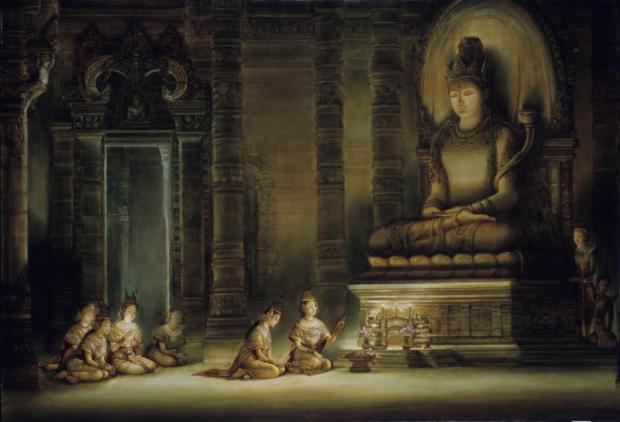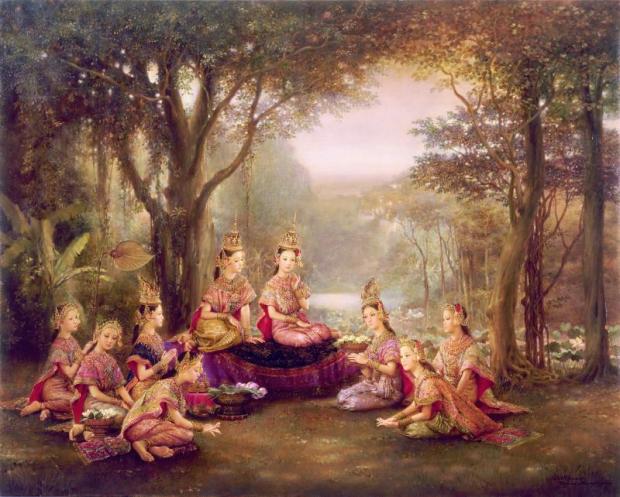The latest artwork of Chakrabhand Posayakrit, Thailand's best-known painter, is the most surprising of the master's prolific oeuvre.
The 72-year-old artist has exploited a watercolour blowing technique to create the abstract art pieces titled A Lion and Gibbons, departing from his signature classical painting.
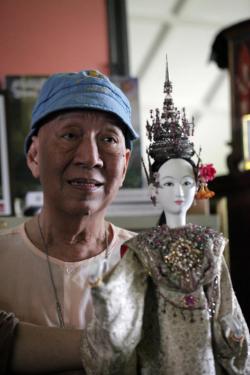
PULLING STRINGS: Chakrabhand has been instrumental in reviving traditional Thai puppetry as a performer and through designing costumes. Above, Chakrabhand was trained in sculpture from a young age. Below right, sketching landscapes in 2008, which served as a journal of his travels and inspiration for his paintings.
Unconventional artworks, Gibbons and A Lion were created with drops of watercolour paint he blew through a straw. At the bottom is his signature dated Jan 20, this year.
Phansakdi Chakkaphak, a well-known painter who handled the design of a commemorative book celebrating Chakrabhand's career, said the works took him by surprise.
"At that time, I was about to finish The 72 Years of Chakrabhand Posayakrit. Then, I got a phone call from the hospital, telling me that Ajarn Chakrabhand just produced these two pieces," Phansakdi said.
"We included the two pieces at the last minute. Even the force of his breath is an artwork," Phansakdi said animatedly during an interview with Brunch.
Phansakdi is among the team who produced the 72 Years collection, a beautifully presented two-volume book which went on sale last week. It is one of several projects that have marked Chakrabhand's sixth-cycle birthday over the past 10 months; the artist turns 73 on Aug 16.
The proceeds will support the Chakrabhand Posayakrit Foundation's projects to promote art by training apprentices, holding exhibitions, painting temple murals and reviving traditional Thai puppetry.
The book was delayed almost a year because of the team's painstaking effort to put together so many artworks and conduct the research required. Named a National Artist in 2000, he has produced several thousand paintings.

Chakrabhand and his team were also working on a new puppetry show, titled Taleng Phai, and were planning public performances soon. However, in November last year, he >> >> suffered a stroke and was admitted to hospital. Chakrabhand is recovering, and his art projects are temporarily suspended.
During a 30-minute interview with his staff and fellow painters, Chakrabhand could not speak much but sat attentively and nodded throughout. When his art teachers were mentioned, he welled up.
Despite physical limitations, Chakrabhand never stopped painting. As he could not move his right arm, he switched to the paint blowing technique to create the two pieces from his hospital bed. While they are a major departure from his signature style, they still show imagination.
Chakrabhand's determination to keep painting, in whatever form, reminded his colleagues of when he was healthy. Chakrabhand liked to travel to the countryside to sketch.
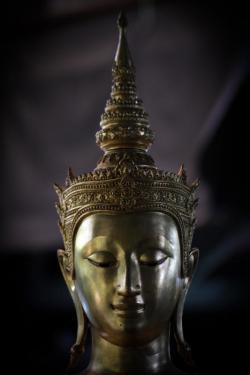
"He was at peace when he drew landscapes in a natural setting," said Vallabhis Sodprasert, who has been working with Chakrabhand since they were art students almost 50 years ago.
ALWAYS SEEN, RARELY HEARD
Chakrabhand is arguably the most popular painter in Thailand. The media-shy artist hardly ever grants interviews but his artworks are almost omnipresent. In addition to his distinctive style of delicate lines and precise details, his works have been widely seen and appreciated by the mass audience.
Collections of his paintings -- showing delicate characters in theatricals costumes -- regularly feature in charity New Year's postcards for a number of organisations, including the Children's Hospital. He drew illustrations and wrote columns for women's magazines.
Over the past four decades, Chakrabhand has been instrumental in reviving traditional Thai puppetry, both as a puppeteer and in the creation of the costumes.
His first performance was in 1975, with a show based on Thai folklore titled Phra Abhai Manee. A series of puppetry shows titled Nang Loi and Romance of the Three Kingdoms, based on Chinese literature, came after with critical success.
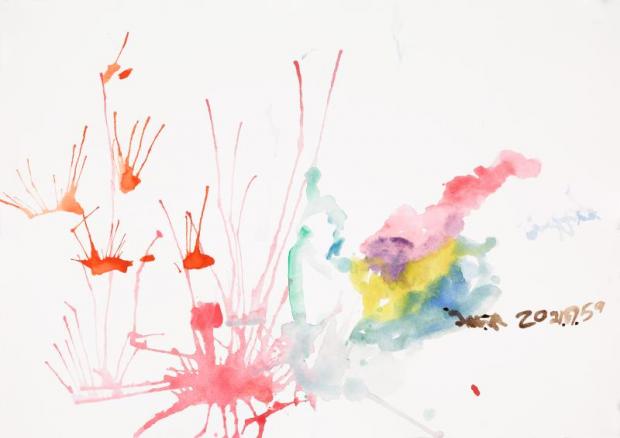
His illness has delayed Taleng Phai, but the team says it will still go ahead: they plan to debut the show at the Chakrabhand Foundation's art museum, but the date for the debut hasn't been set pending his recovery. Rehearsals had started at Chakrabhand's house, and the general public were welcome to watch those free of charge, but they have been postponed.
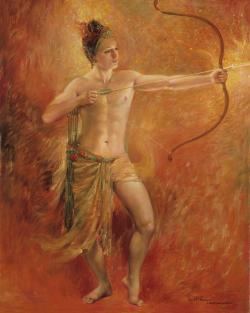
"It's going to be a spectacular performance, when it officially debuts," Vallabhis said.
The 72 years of Chakrabhand Posayakrit, however, focuses on his paintings and is the most comprehensive account of his career yet. Many of the masterpieces were previously gathered in a book published to mark his 60th birthday, but given how prolific he has been it was inevitable works were left out.
"He loves all his works as if they were his own children," Vallabhis said. "So, we spent time debating the selection of the paintings."
The book also features pen drawings of forest and country landscapes. "He draws sketches and illustrations of landscapes as a journal to record his journey," Vallabhis said.
The 72 Years also includes an essay written by Chakrabhand, telling the readers who inspired him to paint.
Nopamat Veohong, who worked on the content and translated the book into English, said Chakrabhand had originally planned to write only a six-page preface.
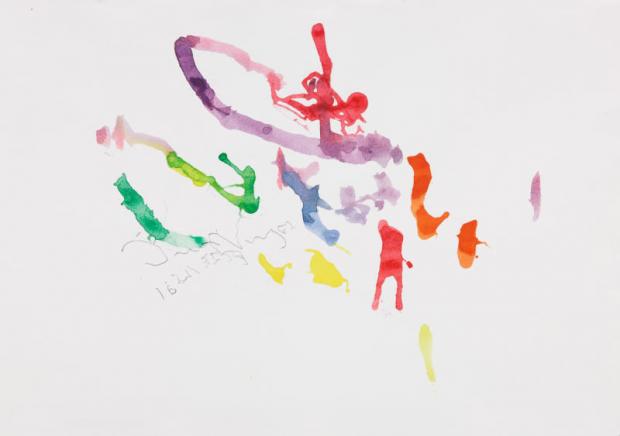
All in the details: Chakrabhand Posayakrit's paintings over 50 years have drawn on Thai mythology and Western techniques. Above right, Chakrabhand paints King Rama VI in 2012. Below right, he created 'Gibbons' and 'A Lion' while recovering in hospital, blowing the paint through a straw.
But after Nopamat volunteered to research his previous writing and put together clippings, the essay ended up covering more than 40 pages in the two volumes.
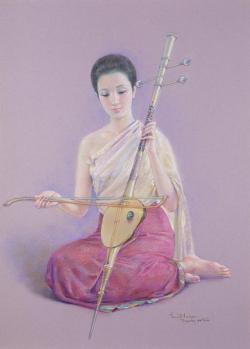
Chakrabhand dedicated a large section to explaining what he learned from each art teacher in different stages of his career.
The oil painting titled Bayan-Praseran, showing two characters in traditional Thai costume, was selected as the cover. "I think that the painting showcases the combination of Thai style and Western technique," Vallabhis said.
Phansakdi added, "We hope that art students will be able to learn from studying how his works have evolved. They are masterpieces, even the ones he drew when he was young."
Readers can see how Chakrabhand has evolved from using thick and bold brushstrokes influenced by impressionism to his most prominent style exploring the elegance of mythical characters in Thai literature. The collection also shows his skill as a fine portrait artist.
BACK TO THE BEGINNING
The earliest inclusions in the book are Chakrabhand's drawings of Thai dancers in full costume with chada from when he was seven and using coloured pencils.
In the second grade, Chakrabhand joined a Vajiravudh school field trip to see khon and lakorn theatre produced by the Department of Fine Arts.
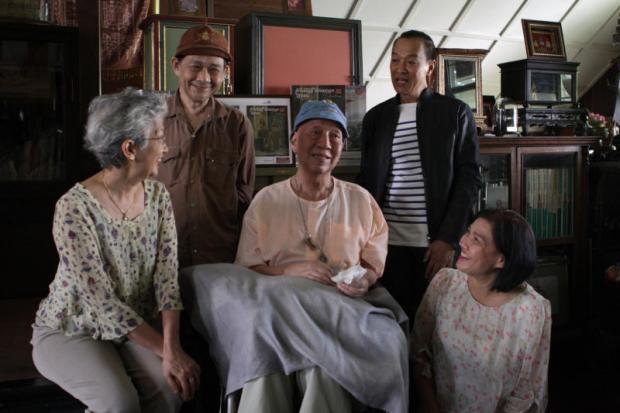
ART COLLECTIVE: Artists Nopamat Veohong, Vallabhis Sodprasert, Chakrabhand Posayakrit, Phansakdi Chakkaphak and Chakrabhand Posayakrit Foundation board member Watcharaporn Arjharn.
The performance of Inao gave him the inspiration for a theme he would continue to explore throughout his career.
Chakrabhand wrote in his book, "On my return from the >> >> dazzling classical theatre, I did so many paintings of dancing figures wearing acutely pointed headdresses."
Back in school, he also crafted a shoddy cardboard toy horse to play with, based on a two-dimensional painted horse attached to a character in the play.
"My artistic penchant led to the creation of my own magical world inflamed by a child's fantasy."
His childhood fascination has, since then, set the path of his artistic career.
In his book, Chakrabhand traced his passion for art from first grade at Vajiravudh. Although art class was a low priority for the school with only half an hour a week, the young Chakrabhand immersed himself in drawing.
From Grade 5, art became an elective subject. Chakrabhand began clay modelling and painting. He was introduced to Paitoon Muangsomboon, an artist who was also an teacher at Vajiravudh.
"Before entering the studio, Paitoon had the kids line up in order and scrutinised their fingers. He said sculptors were not supposed to have long nails because they would get in the way when working," Chakrabhand wrote.
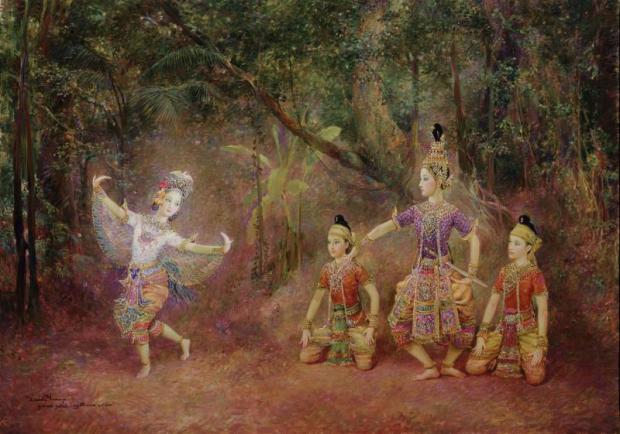
In high school, Chakrabhand was recognised as a good painter but did not excel academically. He almost did not finish high school.
His parents took him to learn with other artists including Prem Saiyawongs. When Ercole Manfredi, an Italian architect who worked and lived in Thailand, met young Chakrabhand, he seemed to know he was destined for greatness.
"Manfredi showed me miniature portraits in watercolours on small oval-shaped ivories of a cross-sectioned tusk," he wrote.
The Italian later gave his wooden easels to Chakrabhand even though the younger artist had yet to learn how to use one.
"It was not until I started painting in oil as a serious painter," that he began using the easels he inherited. They still stand in Chakrabhand's studio, a corner in the upper floor of his house, and are in use to this day.
LEARNING FROM THE MASTERS
Chakrabhand was introduced to another Italian, Corrado Feroci, while still in high school. Feroci, a sculptor under the reign of King Rama VI, was later known as professor Silpa Bhirasri, the founder of the Fine Arts School or Silpakorn University.
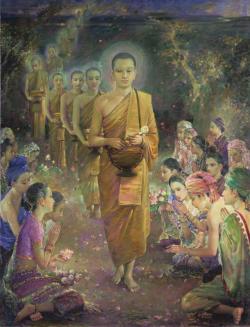
"The first time I visited his residence on Soi Sailom, he had me draw with a black pencil on white paper after professor Khian Yimsiri's sculpture entitled Khlui Thip which was in his study while he was sitting behind a typewriter."
Silpa also taught Chakrabhand how to hold a pencil for drawing. Instead of holding it with three fingers like when writing, "He suggested I try the five-finger technique, with the palm down, without elaborating."
Once Chakrabhand had to paint Isravinitchai Hall in watercolour with a view of Buddhaisawan Hall in the background at midday. Chakrabhand wrote in his book, "my sheer ignorance led me to daub on the magenta as I saw it."
When Chakrabhand showed the painting to Silpa, the Italian told him that the magenta shade he used gave the impression of heat. Silpa's advice was Chakrabhand's first lesson in the theory of colour.
However, Silpa died before Chakrabhand's first year at Silpakorn University began.
Although Chakrabhand did not have the luck to study with him formally, he said the discipline Silpa imparted remains intact.
"The Faculty of Painting and Sculpture opened up a whole new world to me." He studied a wide range of crafts such as oil painting, sculpture, art history, architecture and perspective.
But everything eventually comes down to the basics. "The fundamental course we had to take throughout the five years, or throughout our artistic lives, was drawing. If a person doesn't know ABC, how can he write a book or poetry?" n
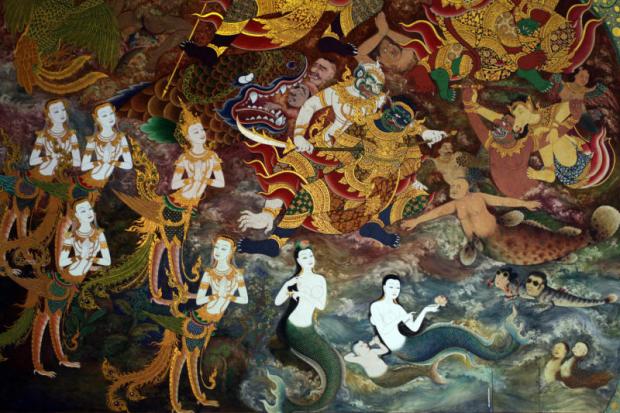
ON THE WALL: Chakrabhand's mural at Wat Trithotsathep. Above left, an apprentice works under Chakrabhand's supervision.

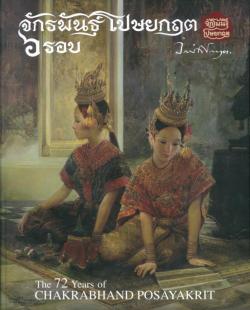
NEW RELEASE: The two-volume set costs 6,000 baht and is available at the foundation.
